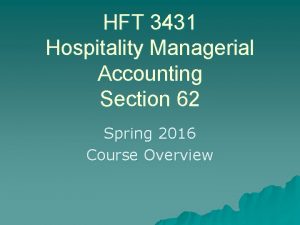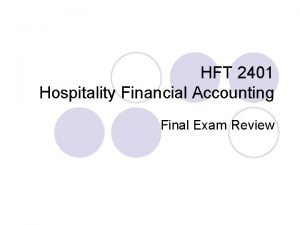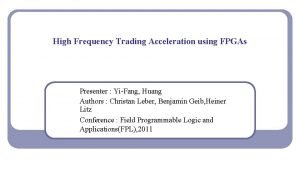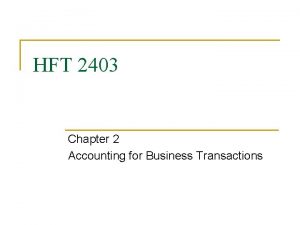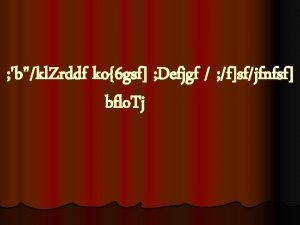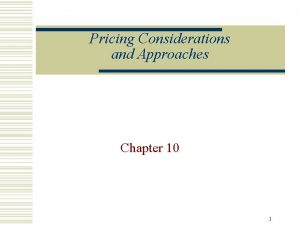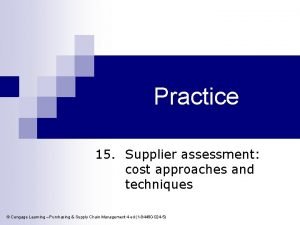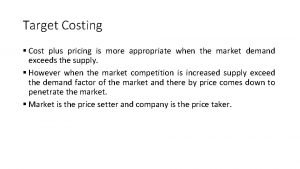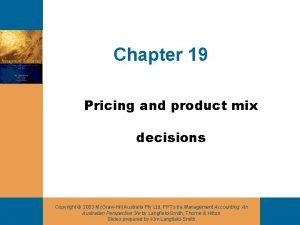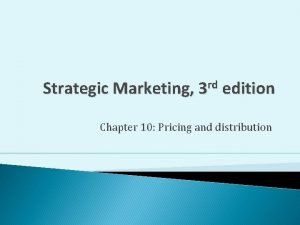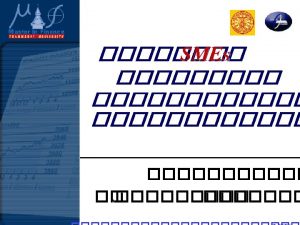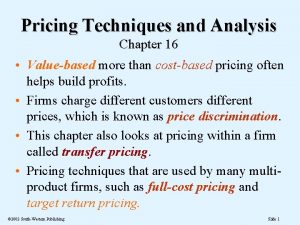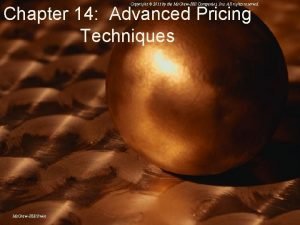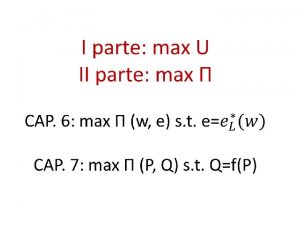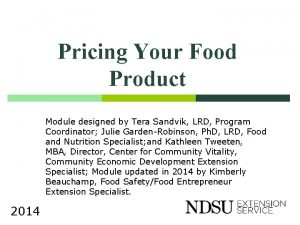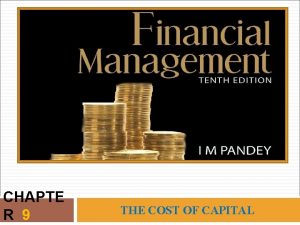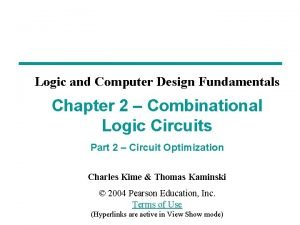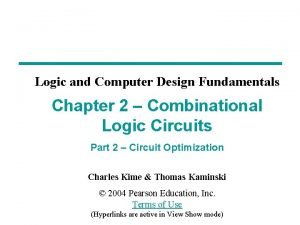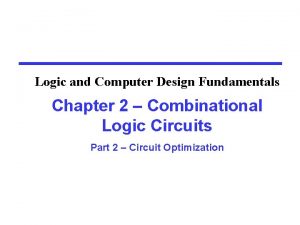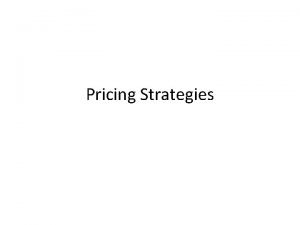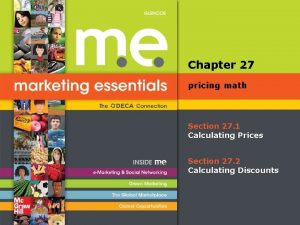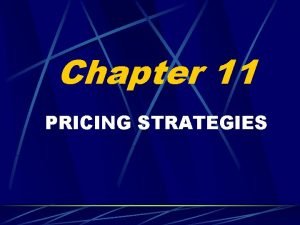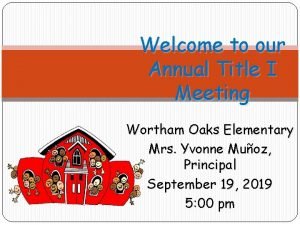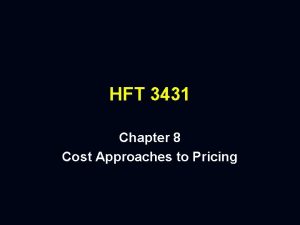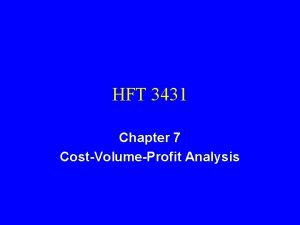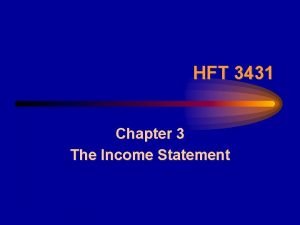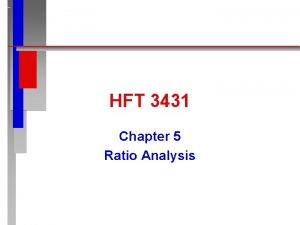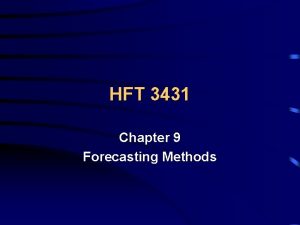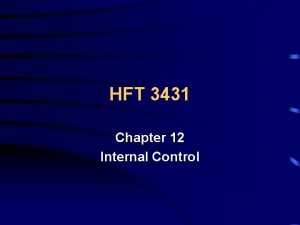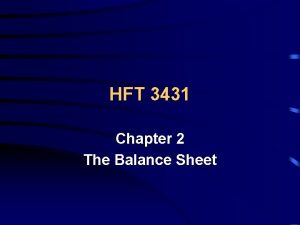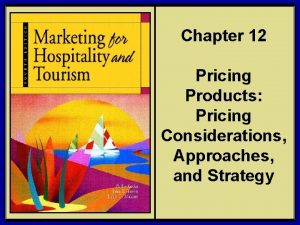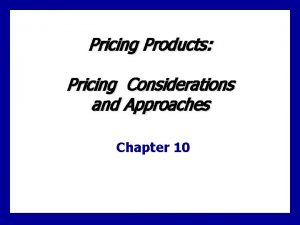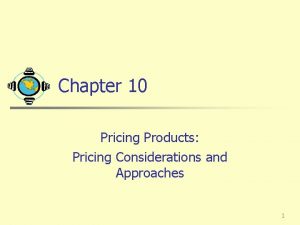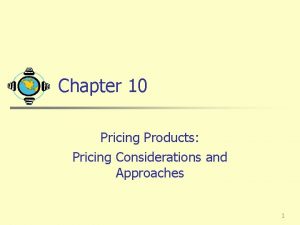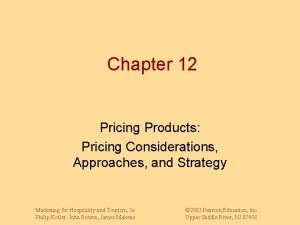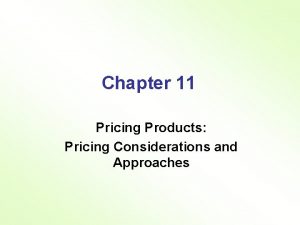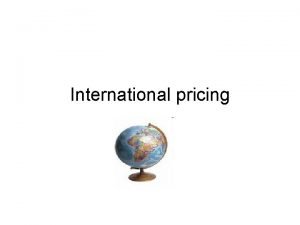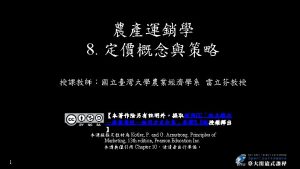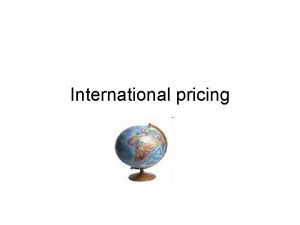HFT 3431 Chapter 8 Cost Approaches to Pricing






















































- Slides: 54

HFT 3431 Chapter 8 Cost Approaches to Pricing

Pricing Questions Which Costs Are Relevant in the Pricing Decision? n What Is the Common Weakness of Informal Pricing Methods? n What Are Common Cost Methods of Pricing Rooms? n

Pricing Questions What Are Common Methods of Pricing Food and Beverages? n How May Profitability and Popularity Be Considered in Setting Food Prices? n

Pricing Questions n Will Departmental Revenue Maximization Result in Revenue Maximization for the Hospitality Firm?

Pricing Questions What Is Integrated Pricing? n What Is Price Elasticity of Demand? n

Price Elasticity of Demand Measures How Sensitive Demand Is to Changes in Price n Either Elastic or Inelastic n

Price Elasticity of Demand n Computed by Dividing % Change in Quantity Demanded by Base Quantity BY % Change in Price by Base Price (Q 2 - Q 1) / Q 1 (P 2 - P 1) / P 1

Price Elasticity of Demand Assume Hotel Sells 1, 000 rooms @ $30 n Changes Price to $33 and sells 950 n (950 - 1, 000)/1, 000 (33 - 30)/30 = - 0. 05 / 0. 10 = -0. 50 Inelastic

Price Elasticity of Demand n If Less Than 1 - Inelastic (Demand Is Insensitive to Price Changes) – An increase in price is offset by a smaller decrease in demand – Normally results in more profits with a price increase – An decrease in price is offset by a smaller increase in demand – Normally results in less profits with a price decrease

Price Elasticity of Demand n If Greater Than 1 - Elastic (Demand Is Sensitive to Price Changes) – An increase in price is offset with a higher decrease in demand – Normally results in less profits with a price increase – An decrease in price is offset with a higher increase in demand – Normally results in more profits with a price decrease (up to a point)

Price Elasticity of Demand Competition, Uniqueness Affect Elasticity n When Change Prices, Test for Elasticity n

Informal Pricing Methods Competitive n Intuitive n Psychological n Trial and Error n Follow The Leader n

Informal Pricing Methods Four Modifying Factors Consider First: n Historical Price Changes n Guest Perceptions (Price/value) n Competition n Modify by Rounding n

Mark Up Approaches Ingredient Mark Up n Determine Ingredient Costs n Determine Multiple to Use n Multiply Costs by Multiplier n Adjust Using Qualitative Factors n

Multiplier 1 / Desired Food Cost Percentage n Example 1 / 40% = 2. 5 n

Alternative to Multiplier Divide Costs By Desired Food Cost Percentage n Example $3. 00 Cost / 40% = $7. 50 Selling Price n

Ingredient Mark Up Approach n If total ingredients cost $1. 32 and you have a 40% desired Food Cost – Multiplier = 1/0. 4 = 2. 5 – Suggested Price = $1. 32 * 2. 5 = $3. 30 – Would suggest rounding to $3. 50

Mark Up Approaches Prime Ingredient Mark Up n Determine Prime Ingredient Cost n Some Versions Add in a Fixed Dollar Amount for Other Ingredients n

Mark Up Approaches Prime Ingredient Mark Up (Continued) n Determine Multiple to Use - Higher Than Mark up (Arbitrary) n Multiply Costs by Multiplier n Adjust Using Qualitative Factors n

Prime Ingredient Mark Up Approach n If Prime Ingredients cost $0. 59 and you have a Prime Multiplier of 7. 8 – Suggested Price = $0. 59 * 7. 8 = $4. 60 – Would suggest rounding to $4. 75 – Note, the Prime Multiplier is based on history or industry standards there is not a formula for it. It is usually higher than the ingredient multiplier

Rooms Pricing Traditional Method $1 Per $1, 000 Cost Per Room n Doesn’t Consider Current Value n Doesn’t Consider Other Services n Assumes 70%occupancy n Assumes Profitable Food and Beverage n

Rooms Pricing Traditional Method n If $100, 000 to build a 5, 000 room hotel = 100, 000 / 5, 000 = 20, 000 per room / $1, 000 = $20. 00 per room rate

Rooms Pricing Hubbart Formula “Bottoms Up” n Start With Profit n Determine Pretax Profit n

Rooms Pricing Hubbart Formula Add in Fixed Charges n Add in Undistributed Operating Costs n Estimate Non Room Income (Loss) n Sum Is Rooms Department Income n

Rooms Pricing Hubbart Formula Rooms Revenue Equals Rooms Income Plus Rooms Department Costs n ADR = Room Revenue / Rooms to Be Sold n n See page 371 for example

ADR to Single and Double Rates (Singles Sold * Single Rate) + (Doubles Sold * (Single Rate + Price Differential)) = Average Rate * Rooms Sold n Solve for Each Rate n

Rate Calculation Assume 200 room hotel with occupancy of 75% and double occupancy of 40% with ADR or 67. 81 (doubles are $10 more than singles n Sell (. 75 * 200) 150 rooms per day n 90 singles 60 doubles

Rate Calculation Let X = Single Room Rate n 90 x + 60(x + 10) = 67. 81 * 150 n 90 x + 600 = 10, 171. 50 n 150 x = 9, 571. 50 n x = 63. 81 Single Rate x + 10 = 73. 81 Double Rate n

Yield Management Increasing the Rooms Revenue

Yield Management Take the Guess Work out of Your Rooms Inventory n The Business of Selecting the Most Profitable Reservations n Yield Management Is the Process of maximizing the total revenues, rather than selling more rooms n

Why Yield Management ? Increase Room Revenues n Improve Total Corporate Profitability n Enter New Markets With Strategic Pricing n Identify and Respond More Quickly to Changing Market Trends n Manage Distribution Channels More Effectively n

What We Gain Is: n Assume 100 room hotel and you can sell either to business or group: – Business - ADR = $80 – Business books 1 week out, and have 40 business guests already booked and can book 55 more in the next 3 weeks – Group - ADR = $55 – Groups books 3 week out – It is 4/1/02 and a group wants to book 20 rooms for 4/21 -11/02

What We Gain Is: n Option 1 Accept the Group Rooms 20 * $55. 00 = $1, 100 Business Rooms 80 * $80 = $6, 400 Total $7, 500 n Option 2 - Reject the Group Business Rooms 95 * $80 =$7, 600 n Since only $100 difference look at the overall revenue that will be generated from each option (ie food and bev)

Menu Engineering A Tool to Increase Food and Beverage Profits

Breaking Out of the Box Is It Really Important to Sell Each Guest a Selection From Each Part of the Menu? n Is Food Cost Percentage the Best Measurement of Performance? n

Breaking Out of the Box Can We Determine the Exact Labor Cost for Each Item Sold on the Menu? n Should Selling Prices Be Determined on a Consistent Mark-up Basis? n

Selling the Entire Menu Drives up Check Average and That Is Good n Additional Points of Service Reduces Seat Turnover n Waiting Time for Table May Cause Loss of Customer n

Selling the Entire Menu n Would You Rather Serve a Dessert at a Cost of $2 for $5 or an Entrée at a Cost of $4 for $10?

Food Cost Percentage Ratio of Cost of Goods Sold to Sales n Gross Profit Is Sales Minus Cost of Goods Sold n Objective Is to Increase Gross Profit n

Food Cost Percentage Do You Deposit Percentages or Dollars? n Item “A” Costs $4 and Sells for $12 or 33% n Item “B” Costs $8 and Sells for $20 or 40% n Which One Would You Rather Serve (All Other Things Being Equal)? n

Labor Cost Labor Is a Mixed Cost - a Fixed Component and a Variable Component n Customer Demand Is Variable on a Daily Basis n Daily Labor Is Scheduled Based on Forecasts Which Inherently Are Imprecise n

Labor Cost Therefore, Exact Labor Cost Quantification on a Per Item Basis Is Impossible to Compute n Can Rank Labor Cost Per Item (High or Low Relative to the Items in the Mix) n

Menu Engineering Smith and Kasavana n Analyzes Popularity and Contribution Margin n Two by Two Matrix n Classified Items As Stars, Dogs, Puzzles, or Plowhorses n

Popularity Item Is Popular If Individual Item’s Sales Mix Exceeds 70% of the Average Popularity n Average Popularity = (100% / Number of Items) * (70%) n

Popularity Example 10 Items n Average Popularity = (100% / 10) * (70%) = 7% n If Individual Sales Mix Is > 7%, The item has HIGH Popularity n If Individual Sales Mix Is < 7%, The item has LOW Popularity n

Contribution Margin Selling Price Minus Variable Costs or Gross Profit n Compute for Each Item n

Weighted Average Contribution Margin Calculation Compute Individual Contribution Margin n Multiply Item Contribution Margin by Number of Item Sales n Result Is Total Contribution Margin n

Weighted Average Contribution Margin Calculation Divide Total Contribution Margin by Number of Sales n Result Is Weighted Average Contribution Margin n

Contribution Margin Compare Against Weighted Average Contribution Margin for Menu Section Engineered n If Item CM Is > WACM - Label “HIGH” n If Item CM Is < WACM - Label “LOW” n

Classifications n Star - High Popularity & High CM – Continue promoting item n Plow Horse - High Popularity & Low CM – Re-price the item to increase CM n Puzzles - High CM & Low Popularity – Promote the item to increase popularity n Dogs - Low CM & Low Popularity – - Drop the item from the menu

Menu Engineering Concerns Ignored Variable Portion of Labor Cost n Inconsistent With Performance Evaluation n Difficult to Collect Data n Extensive Calculations n “So What” Theory n

Adjust Sales Mix Without Cost Create Signature Item High in Contribution Margin n Train Staff on Contribution Margin Principles n Provide Periodic Tastings to Public for Items Low in Popularity but High in Contribution Margin n

Adjust Sales Mix Without Cost Use Internal Marketing Tools n Reevaluate Pricing Strategies Using Data, Profit Factor, and Elasticity of Demand n Consider Profitability When Printing Menus n

 Hft 3431
Hft 3431 Accounting final exam review
Accounting final exam review Fpga high frequency trading
Fpga high frequency trading Hft cable tracker
Hft cable tracker Hft 2220
Hft 2220 Hft 4464
Hft 4464 Normal balance
Normal balance Lsf hft
Lsf hft General pricing approaches
General pricing approaches Pricing considerations and approaches
Pricing considerations and approaches Pricing approaches
Pricing approaches Supplier evaluation techniques
Supplier evaluation techniques Target costing vs cost plus pricing
Target costing vs cost plus pricing Cost plus pricing formula
Cost plus pricing formula Full cost pricing of a refrigerator would include
Full cost pricing of a refrigerator would include Pricing decision and cost management
Pricing decision and cost management Constructreach
Constructreach Cost plus loan pricing model
Cost plus loan pricing model Costing and pricing
Costing and pricing Cost plus pricing
Cost plus pricing Eplicita
Eplicita Selling price formula
Selling price formula Cost-based pricing formula
Cost-based pricing formula Cost accumulation and cost assignment
Cost accumulation and cost assignment Cost accumulation and cost assignment
Cost accumulation and cost assignment Manufacturing cost vs non manufacturing cost
Manufacturing cost vs non manufacturing cost Job costing with process costing
Job costing with process costing Floatation cost
Floatation cost Cost concept and classification
Cost concept and classification Cost pools
Cost pools Manufacturing cost vs non manufacturing cost
Manufacturing cost vs non manufacturing cost Material price variance
Material price variance Opportunity cost of equity capital
Opportunity cost of equity capital Cost accumulation and cost assignment
Cost accumulation and cost assignment Cost control and cost reduction difference
Cost control and cost reduction difference Definition of standard cost
Definition of standard cost Literal cost gate input cost
Literal cost gate input cost Distinguish between average cost and marginal cost
Distinguish between average cost and marginal cost Cost control and cost reduction difference
Cost control and cost reduction difference The flow of costs in job order costing
The flow of costs in job order costing Ordering cost and carrying cost
Ordering cost and carrying cost Literal cost gate input cost
Literal cost gate input cost Literal cost gate input cost
Literal cost gate input cost Opportunity costs and trade offs
Opportunity costs and trade offs Cost control and cost reduction project report
Cost control and cost reduction project report Cost control and cost reduction project report
Cost control and cost reduction project report Cost structure refers to the relative proportion of
Cost structure refers to the relative proportion of Chapter 26 pricing strategies answer key
Chapter 26 pricing strategies answer key Chapter 27 pricing math
Chapter 27 pricing math Chapter 11 pricing strategies
Chapter 11 pricing strategies Chapter 26 pricing strategies
Chapter 26 pricing strategies Wid, wad, gad
Wid, wad, gad Approaches meets masters
Approaches meets masters Unit 1 psychology's history and approaches
Unit 1 psychology's history and approaches How did wilhelm wundt break down consciousness
How did wilhelm wundt break down consciousness
